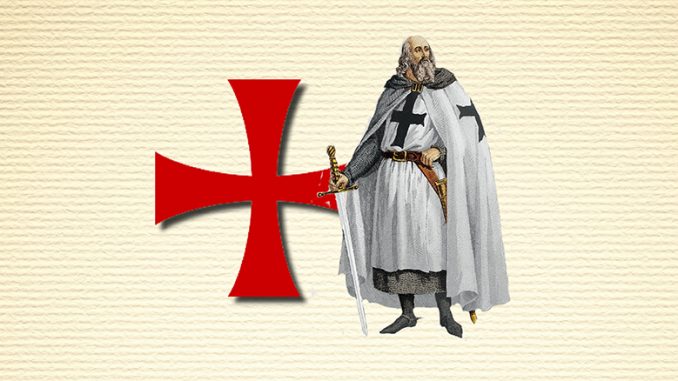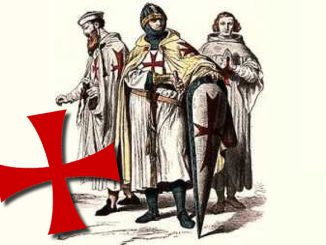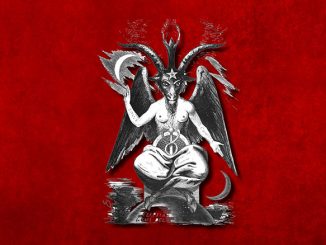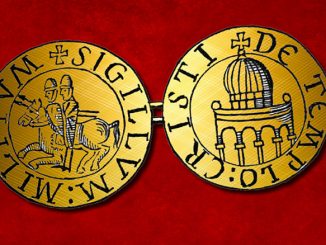
The Templar Grand Masters – Overview and entourage
Within the Templar hierarchy, the Grand Master was absolute ruler of the Order and answerable only to the pope. Although his position was a powerful one, he was still obliged to live by the same Rule of Order that those under him swore to obey. However, the Rule did grant him a fairly extensive entourage:
4 horses
1 Chaplain Brother
1 clerk with 3 horses
1 Sergeant Brother with 2 horses
1 gentleman valet with 1 horse
1 farrier
1 Saracen scribe
1 turcopole
1 cook
2 foot soldiers
1 turcoman
2 knight brothers as companions
Source: The Rule of the Templars Upton Ward p. 39
Base of Operations
From the Order’s foundation in 1119/1120 until the fall of Jerusalem the Grand Master was headquartered in Jerusalem. From 1191 until 1291, he was stationed at Acre and after the loss of the port city in 1291, was stationed on the Island of Cyprus.
List of Templar Grand Masters From 1118 – 1314
While historians generally agree on the names of the men who led the Order over its nearly 200 years of existence, there is considerable disagreement in the dates that some individual Grand Masters held their post. The list below has been compiled from the works of Malcolm Barber.
1 – 1119-1136 Hugues de Payens
Hugues de Payens (1119-1136) was a prominent figure in the early history of the Knights Templar. As one of the founders of the order, he played a crucial role in its establishment and development. Hugues, along with a small group of knights, offered their services to the Patriarch of Jerusalem, dedicated to protecting Christian pilgrims visiting the Holy Land. Under his leadership, the Templars gained recognition and support, eventually receiving quarters in the Royal Palace on the Temple Mount. Hugues de Payens contributed to the growth and organization of the Templar Order, as the first of the Templar Grand Masters, setting the stage for its future prominence in the Crusades and European history.
2 – 1136-1149 Robert de Craon
Robert de Craon (1136-1149) was a prominent figure in the Knights Templar, serving as the second Grand Master of the order. He succeeded Hugues de Payens and played a crucial role in expanding and solidifying the Templars’ influence and power. During his tenure, Robert focused on strengthening the order’s military capabilities and establishing a network of Templar commanderies across Europe and the Holy Land. He actively participated in the defense of the Crusader states and led the Templars in various battles. Robert de Craon’s leadership and strategic vision contributed to the Templars’ continued growth and prominence as a formidable military and financial force during the Crusades.
3 – 1149-1152 Everard des Barres
Everard des Barres (1149-1152) served as the third Grand Master of the Knights Templar, succeeding Robert de Craon. During his short tenure, Everard focused on consolidating the Templars’ position in the Holy Land and strengthening their military presence. He played a crucial role in defending the Crusader states against Muslim forces and participated in several key battles. Despite his brief time as Grand Master, Everard’s leadership skills and dedication to the Templar cause left a lasting impact on the order. His efforts helped to maintain the Templars’ influence and contributed to their reputation as elite warriors during the tumultuous period of the Crusades.
4 – 1153-1153 Bernard de Tramelay
Bernard de Tramelay, also known as Bernard de Tremelay, was a prominent figure in the history of the Knights Templar. He served as the 4th Grand Master of the Order from 1151 to 1153. Not much is known about his background or early life. During his time as Grand Master, Bernard oversaw the Templars’ operations and expansion in the Holy Land. He faced challenges from political tensions and conflicts with other military orders. Unfortunately, his tenure was cut short when he was captured and killed by the Muslim forces in 1153. Bernard de Tramelay is remembered as one of the notable leaders of the Knights Templar during the Crusades.
5 – 1154-1156 Andrew de Montbard
Andrew de Montbard, also known as André de Montbard, was a significant figure within the Knights Templar. He played a crucial role in the early years of the Order and had a close association with its founder, Hugues de Payens. Andrew de Montbard was the uncle of Hugues de Payens and joined the Templars alongside him. He became one of the founding members and served as a trusted advisor to Hugues. Andrew participated in the Templars’ missions and played an essential role in shaping the Order’s ideals and principles. His dedication and commitment to the cause of the Knights Templar contributed to their growth and influence. Although specific details about his life are limited, Andrew de Montbard remains a notable figure in the history of the Knights Templar.
6 – 1156-1159 Bertrand de Blancfort
Bertrand de Blancfort was a prominent figure associated with the Knights Templar during the 12th century. He served as the 6th Grand Master of the Order from 1156 to 1169. Under his leadership, the Templars experienced significant growth and expansion, establishing new commanderies and strengthening their presence in the Holy Land. Bertrand played a crucial role in securing support and resources for the Templars, forging alliances with influential figures and monarchs of the time. He also worked to refine the organization’s internal structure and rules, ensuring the adherence to the Templar code of conduct. Bertrand de Blancfort’s tenure as Grand Master marked a period of prosperity and development for the Knights Templar, contributing to their rise as a formidable military and religious order.
7 – 1169-1171 Philip de Milly (Nablus)
Philip de Milly was a prominent figure associated with the Knights Templar during the 12th century. He served as the 7th Grand Master of the Order from 1169 to 1171. Philip hailed from a noble family in the Kingdom of Jerusalem and was known for his military prowess and dedication to the Templar cause. During his leadership, Philip played a crucial role in defending the Christian territories in the Holy Land against the forces of Salah ad-Din (Saladin) during the tumultuous period of the Crusades. He led the Templars in various battles and skirmishes, showcasing their military strength and strategic capabilities. Philip de Milly’s leadership and bravery contributed to the Templars’ reputation as formidable warriors and defenders of the faith.
8 – 1171-1179 Odo de St Amand
Odo de St Amand was a prominent figure within the Knights Templar during the 12th century. He served as the sixth of the Templar Grand Masters from 1171 to 1179. Odo’s tenure as Grand Master coincided with a challenging period for the Templars, as they faced continued conflicts in the Holy Land. During his leadership, Odo focused on strengthening the Order’s military capabilities and fortifying Templar castles and holdings. He also played a significant role in maintaining alliances with other Crusader orders and European powers. Odo de St Amand’s leadership contributed to the Templars’ resilience and enduring presence in the Holy Land during a tumultuous era of the Crusades.
9 – 1181-1184 Arnold de Torroja
Arnold de Torroja was a notable figure in the history of the Knights Templar. He served as the 9th Grand Master of the Order from 1184 to 1189. Arnold’s leadership came at a critical time when the Templars faced escalating conflicts and challenges in the Holy Land. Under his guidance, the Templars continued their efforts to defend Christian territories and maintain their strategic positions. Arnold emphasized the importance of discipline and adherence to the Templar Rule, ensuring that the Order operated with efficiency and unity. Despite the difficulties faced during his tenure, Arnold de Torroja played a crucial role in upholding the Templars’ mission and bolstering their influence in the Crusader states.
10 – 1185-1189 Gerard de Ridefort
Gerard de Ridefort was a prominent figure in the history of the Knights Templar. He served as the Grand Master of the Order from 1185 until his death in 1189. Known for his military prowess and strategic leadership, Gerard played a crucial role in defending and expanding the Templars’ presence in the Holy Land during a tumultuous period. He led the Templars in various campaigns, including the Siege of Jerusalem in 1187. Despite facing setbacks and challenges, Gerard’s determination and dedication to the Templar cause inspired his fellow knights. His leadership and bravery in the face of adversity made him a respected figure among his peers and adversaries alike. Gerard de Ridefort’s legacy continues to be remembered as an important chapter in the history of the Knights Templar.
11 – 1191-1192/3 Robert de Sable
Robert de Sable, also known as Robert of Sablé, was a prominent figure in the history of the Knights Templar. He served as the Grand Master of the Order from 1191 until his death in 1193. During his tenure, Robert faced the challenging task of leading the Templars during the Third Crusade. He played a crucial role in defending the Holy Land and coordinating military campaigns against the forces of Saladin. Known for his tactical skills and strategic acumen, Robert led the Templars in several notable battles, including the Battle of Arsuf. Under his leadership, the Templars maintained their reputation as a formidable fighting force. Robert de Sable’s contributions to the Knights Templar and his dedication to their cause are remembered as an important part of the Order’s history.
12 – 1194-1200 Gilbert Erail
Gilbert Horal, also known as Gilbert Erail or Erill, was the 12th Grand Master of the Knights Templar in the late 12th century. His leadership was characterized by growing tensions between the Templars and the Hospitallers, as well as the consolidation of Templar holdings in France and Apulia. Born in Aragon, Horal joined the Templars at a young age and played a role in the Reconquista in Spain. He later became the Grand Preceptor of France before being elected as the Grand Master after the death of Robert de Sablé. Horal advocated for peace between Christians and Muslims, which caused controversy and strained relations between the Templars and the Hospitallers. Under his leadership, the Teutonic Knights emerged as a significant military order, and notable fortresses like Pilgrim’s Castle were constructed. Gilbert Horal passed away in December 1200 AD, during the early stages of the Fourth Crusade, and was succeeded by Phillipe de Plessis as the 13th Grand Master.
13 – 1201-1209 Philip de Plessis
Philip de Plessis, also known as Philippe de Plessis or Philip of Naplouse, was the 13th of the Templar Grand Masters. He served during the early 13th century, succeeding Gilbert Horal. Little is known about Philip’s background and early life. During his tenure as Grand Master, the Templars faced ongoing conflicts with the Hospitallers and continued their military activities in the Holy Land. Philip’s leadership saw the Templars participating in the Fifth Crusade, including the famous siege of Damietta in Egypt. However, the Crusade ultimately ended in failure. Philip de Plessis’ exact date of death is unknown, and he was succeeded by Guillaume de Chartres as the 14th Grand Master of the Templars.
14 – 1210-1218/9 William de Chartres
William de Chartres, also known as Guillaume de Chartres, was the 14th Grand Master of the Knights Templar, serving in the early 13th century. Not much is known about his early life and background. During his time as Grand Master, the Templars continued their military activities in the Holy Land and participated in the failed Fifth Crusade. William de Chartres faced challenges from within the Order, including internal conflicts and tensions with other military orders. He worked to maintain the Templars’ influence and possessions in the region. The exact details of his death and the end of his leadership are unclear, but he was succeeded by Theobald Gaudin as the 15th Grand Master of the Templars.
15 – 1219-1230/2 Peter de Montaigu
Peter de Montaigu, also known as Pierre de Montaigu, was a prominent figure in the history of the Knights Templar. He served as the 15th Grand Master of the Order during the early 13th century. Little is known about his background and early life. During his tenure, the Templars faced increasing pressure and hostility from various forces, including political and religious authorities. Peter de Montaigu worked diligently to defend the interests and assets of the Templars in the face of these challenges. However, the order’s fortunes continued to decline, and it eventually faced persecution and suppression. The circumstances surrounding Peter de Montaigu’s death and the end of his leadership are unclear, but his tenure marked a tumultuous period in the history of the Knights Templar.
16 – 1232-1244/6 Armand de Perigord
Armand de Périgord, also known as Armand de Périgord-Beynac, was a prominent member of the Knights Templar during the 13th century. He served as the 16th of the Templar Grand Masters from 1247 to 1256. Not much is known about his early life or background, but he played a significant role in the Templars’ activities during his tenure. Armand de Périgord led the Order during a challenging period, marked by conflicts with other military orders and political powers. Under his leadership, the Templars expanded their influence and possessions, particularly in France. However, their wealth and power also made them targets of envy and suspicion. Armand de Périgord’s time as Grand Master came to an end when he was succeeded by Thomas Bérard. The exact circumstances of his later life and death are not widely documented. Nonetheless, Armand de Périgord played a notable role in the history of the Knights Templar during a critical period.
17 – Not Listed Richard de Bures
Richard de Bures was a member of the Knights Templar. Not much is known about his early life, but he played a significant role within the Order. Richard de Bures served as the Preceptor of Normandy and later became the Preceptor of Cyprus. He was present during the defense of the coastal city of Acre during the Crusades. Richard de Bures is best known for his account of the Siege of Acre, where he provided a detailed description of the events and the valiant efforts of the Templars and other Crusaders. His writings offer valuable insights into the military strategies and challenges faced by the Templars during this critical period. Richard de Bures’ account provides a firsthand perspective on the Crusades and the Templars’ role in defending the Holy Land.
18 – 1247-1250 William de Sonnac
William de Sonnac was the 18th of the Templar Grand Masters, serving from 1247 to 1250. Not much is known about his early life, but he assumed leadership of the Order during a tumultuous period. William de Sonnac faced significant challenges, including the loss of key territories to Muslim forces and internal conflicts within the Templar Order. He attempted to rally support and resources to strengthen the Templars’ position in the Holy Land. However, his efforts were hindered by political tensions and a lack of unity among Christian forces. William de Sonnac’s tenure as Grand Master was cut short when he was captured by Muslim forces during the Battle of Al Mansurah in 1250. He was eventually released but died shortly after his release, leaving a legacy of bravery and resilience in the face of adversity.
19 – 1250-1256 Reginald de Vichiers
Reginald de Vichiers, also known as Reignault de Vichiers, was the 19h Grand Master of the Knights Templar, serving from 1250 to 1256. Little is known about his early life, but he assumed leadership of the Order during a critical period. Reginald de Vichiers faced numerous challenges, including ongoing conflicts with Muslim forces in the Holy Land and internal disputes within the Templar Order. Despite these challenges, he worked diligently to strengthen the Order’s defenses and maintain its influence in the region. However, his time as Grand Master was short-lived, as he passed away in 1256. Although his tenure was brief, Reginald de Vichiers left a lasting impact on the Templar Order through his leadership and dedication to its mission.
20 – 1256-1273 Thomas Berard
Thomas Bérard, the 20th of the Templar Grand Masters, serving from 1256 to 1273, faced numerous challenges during his tenure. He wrote letters to King Henry III of England, highlighting the dire situation in the Holy Land. Bérard also worked towards cooperation with other military orders, overcoming past rivalries. However, in 1266, the Templar fortress of Safed was besieged by Egyptian Mameluks, resulting in the beheading of all Templars and Hospitallers who refused to convert to Islam. More fortresses fell, including Beaufort and Antioch. Despite sending messages to the pope for help and ordering retreats to various locations, the Templars suffered further losses. Bérard’s death on 25 March 1273 marked the end of his leadership and added to the challenges faced by the Knights Templar in the Holy Land.
21 – 1273-1291 William de Beaujeu
William de Beaujeu, also known as Guillaume de Beaujeu, was the 21st Grand Master of the Knights Templar, serving from 1273 until his death in 1291. He played a crucial role in the defense of the Crusader states, particularly during the final years of the Crusades. William de Beaujeu led the Templar forces in the Battle of Acre in 1291, where they fought against the Mamluks. Despite their valiant efforts, the city fell, and William de Beaujeu was taken captive. He refused to renounce his faith and was executed by the Mamluks. His courage and leadership in the face of adversity exemplified the ideals of the Knights Templar.
22 – 1291-1292/3 Theobald Gaudin
Theobald Gaudin, also known as Thibaud Gaudin, was Grand Master of the Knights Templar, serving from 1291 to 1292. He assumed leadership during a critical period when the Crusader states were under significant threat. In 1291, the city of Acre, the last stronghold of the Crusaders in the Holy Land, fell to the Mamluk forces, leading to the collapse of Templar presence in the region. Gaudin played a role in organizing the evacuation and retreat of the Templars to Cyprus. However, his time as Grand Master was short-lived, as he died in 1292. Theobald Gaudin’s leadership marked a challenging phase for the Templars as they faced the loss of their power and influence in the Holy Land.
23 – 1293-1314 Jacques de Molay
Jacques de Molay was the 23rd and final Grand Master of the Knights Templar, serving from 1292 until the Order’s dissolution. He is best known for his role during the downfall of the Templars. In 1307, King Philip IV of France orchestrated a coordinated arrest of Templar members, including de Molay. He endured torture and coercion but refused to confess to the charges of heresy and other crimes brought against the Order. Despite his steadfastness, de Molay and several other Templar leaders were eventually convicted and sentenced to death. On March 18, 1314, de Molay was burned at the stake on the Île de la Cité in Paris, uttering a curse that both the king and the pope would join him in death within a year. His execution marked the end of the Templars as a formal military order, though their legacy and mystery continue to captivate historians and enthusiasts to this day.
About Us
We hope you enjoyed this summary of the Templar Grand Masters.
TemplarHistory.com was started in the fall of 1997 by Stephen Dafoe, a Canadian author who has written several books on the Templars and related subjects.
Read more articles like The Templar Grand Masters from our Templar History Archives – Templar History



